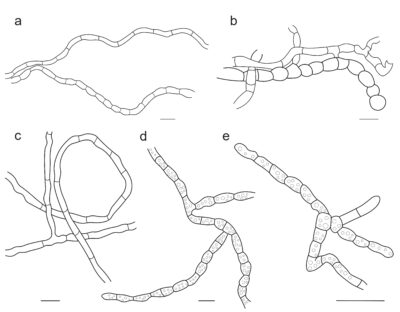Fungalpedia – Note 395, Constantinomyces
Constantinomyces Egidi & Onofri
Citation when using this data: Tibpromma et al. 2024 (in prep.) – Fungalpedia, Rock-inhabiting fungi.
Index Fungorum, Facesoffungi, MycoBank, GenBank, Fig. 1
Classification: Teratosphaeriaceae, Mycosphaerellales, Dothideomycetidae, Dothideomycetes, Pezizomycotina, Ascomycota, Fungi.
Constantinomyces was established by Egidi et al. (2014), with Constantinomyces virgultus designated as the type species. Utilizing Bayesian analysis of LSU, rpb2, ITS, and bt2 sequences, Egidi et al. (2014) positioned Constantinomyces within Teratosphaeriaceae. This placement was further supported by Rubial et al. (2018), who also added two new species to the genus and reaffirmed its classification within Teratosphaeriaceae. Currently, the genus Constantinomyces comprises of six species, as documented by Egidi et al. (2014) and Rubial et al. (2018). The genus is known for typical rock-inhabiting fungi that exhibit two distinctive features: (i) they are found on bare solid surfaces in the Mediterranean region and (ii) they display the characteristic morphology and traits of microcolonial fungi that inhabit surfaces. Constantinomyces is characterized by slow-growing colonies that are velvety and greyish on the obverse and dark on the reverse, with a regular margin that is elevated both centrally and near the periphery. The hyphae are septate, thick-walled and elongated or cylindrical in later stages. Torulose guttulate hyphae, which are brown, thick-walled, and smooth, are occasionally present. However, the teleomorph stage of Constantinomyces remains unknown. Initially, the nomenclature for the genus Constantinomyces was considered invalid under Article 40.7 (Shenzhen) of the nomenclatural rules due to procedural issues in its introduction by Egidi et al. (2014). However, this issue was addressed by Crous et al. (2019), who validated the name Constantinomyces, thus rectifying the initial oversight and establishing it as a valid genus.
Type species: Constantinomyces virgultus Egidi & S. Onofri
Other accepted species: Species Fungorum – search Constantinomyces
Figure 1 – Hyphae of Constantinomyces sp. a Septate hyphae. b Toruloid hyphae. c Elongated hyphae. d Chained, melanized conidia. e Hyphae with short branches. Scale bars: a–e = 10 μm. (a, b) Constantinomyces virgultus (CBS 117930=TRN79), (c) C. macerans (CBS 119304=TRN440), (d) C. nebulosus (CBS 117941=TRN262), (e) C. minimus (CBS 118766=TRN159). Redrawn from Egidi et al. (2014).
References
Entry by
Wanasinghe DN, Center for Mountain Futures, Kunming Institute of Botany, Chinese Academy of Sciences, Honghe 654400, China.
(Edited by Saowaluck Tibpromma, Samaneh Chaharmiri-Dokhaharani, & Achala R. Rathnayaka)
Published online 26 November 2024
